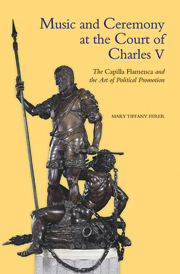 Music and Ceremony at the Court of Charles V
Music and Ceremony at the Court of Charles V Book contents
- Frontmatter
- Contents
- List of Illustrations
- List of Tables
- Preface and Acknowledgements
- List of Abbreviations
- Dedication
- Chapter 1 Charles V: Defender of the Faith and Universal Monarch
- Chapter 2 The Genesis of the Chapel
- Chapter 3 The Reconstruction of the Capilla Flamenca
- Chapter 4 The Chapel Ordinances: Ritual and Repertory at the Court
- Chapter 5 Music and Ceremony at the Court of Charles V
- Chapter 6 Charles V as Crusader and Christian Knight
- Chapter 7 The Presentation of the Emperor
- APPENDIX A Chapel Rosters
- APPENDIX B Chapel Statutes and Ordinances
- APPENDIX C Selected Chapel Personnel
- APPENDIX D Musical Manuscripts, Prints, and Editions
- Glossary
- Bibliography
- Index
Chapter 1 - Charles V: Defender of the Faith and Universal Monarch
Published online by Cambridge University Press: 05 October 2013
- Frontmatter
- Contents
- List of Illustrations
- List of Tables
- Preface and Acknowledgements
- List of Abbreviations
- Dedication
- Chapter 1 Charles V: Defender of the Faith and Universal Monarch
- Chapter 2 The Genesis of the Chapel
- Chapter 3 The Reconstruction of the Capilla Flamenca
- Chapter 4 The Chapel Ordinances: Ritual and Repertory at the Court
- Chapter 5 Music and Ceremony at the Court of Charles V
- Chapter 6 Charles V as Crusader and Christian Knight
- Chapter 7 The Presentation of the Emperor
- APPENDIX A Chapel Rosters
- APPENDIX B Chapel Statutes and Ordinances
- APPENDIX C Selected Chapel Personnel
- APPENDIX D Musical Manuscripts, Prints, and Editions
- Glossary
- Bibliography
- Index
Summary
On 24 February 1530 Charles V, King of Spain, Ruler of the Netherlands, and King of the Romans, was crowned Holy Roman Emperor by Pope Clement VII in an elaborate ceremony at Bologna marked by pageantry and symbolism. Charles ruled over an extensive empire which stretched from the North Sea to the Mediterranean, and from the Danube across the Atlantic to the New World. His realm included the Netherlands and Flanders, Aragon and Castile, the Habsburg territories in Austria and Germany, the duchy of Milan, Bohemia and Hungary, the kingdom of Naples, and the Spanish colonies in the Americas. It was an empire acquired through the fortunes of birth, dynastic marriages, and conquest. His court was one of the most significant political centres of the early 16th century.
The events which brought him to the thrones of Spain and the Holy Roman Empire are familiar to scholars of the 16th century. At his birth he was expected to inherit extensive territories in the Low Countries from his father, Philip the Fair, Duke of Burgundy, as well as the Habsburg territories in Germany and Austria through his paternal grandfather Maximilian, Holy Roman Emperor. Charles's mother was Juana, daughter of Ferdinand and Isabella of Spain. Through the tragic deaths of two older siblings and a nephew, Juana became heiress to the thrones of Castile and Aragon. In 1504, when Isabella died, Philip and Juana became rulers of Castile, and extensive territories in Spain were added to the Habsburg Burgundian holdings in the Low Countries already controlled by Philip the Fair.
- Type
- Chapter
- Information
- Music and Ceremony at the Court of Charles VThe Capilla Flamenca and the Art of Political Promotion, pp. 1 - 25Publisher: Boydell & BrewerPrint publication year: 2012
